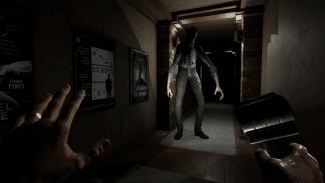Wraith: The Oblivion – Afterlife marks the World of Darkness’ first venture into VR, bringing a frightening survival horror fans won’t want to miss. Read on for our full Wraith: The Oblivion – Afterlife review!
For a group of horror-themed tabletop RPGs, World of Darkness has seriously pushed towards gaming recently. Finding mixed success with recent Vampire: The Masquerade and Werewolf: The Apocalypse adaptations, this shared supernatural universe now ventures towards an obscurer entry, Wraith: The Oblivion. Developed by Fast Travel Games, Afterlife’s narrative-driven survival horror premise is a drastic shift from the team’s previous efforts, such as Apex Construct and The Curious Tale Of The Stolen Pets, delivering a thoroughly creepy experience.
If you’ve not played the original, then fear not. Afterlife sticks closely to the source material but doesn’t assume familiarity with World of Darkness, making this a good introduction. Rather than Vampires and Werewolfs, Wraith begins with the recently deceased, as these new souls emerge inside the Deadlands, haunted by shadows of those we once knew. Rather than a cliched Victorian-era estate, Afterlife utilises a modern setting with Barclay Mansion, home of aging Hollywood actor Howard Barclay.
You’ll play as Ed Miller, a photographer called up to the Barclay Mansion, tasked with photographing a séance. Afterlife begins with Ed’s death, waking up to find he’s become a Wraith, having died during this séance with everyone else. With unfinished business in the realm of the living and no memory of how he died, Ed returns to investigate the mansion’s ruined remains. Witnessing past events unfold before his very eyes, only he can uncover the truth, and it won’t take long for Afterlife’s foreboding atmosphere to kick in.
Now, this isn’t a game reliant on jump scares to get you screaming. Afterlife is clever, opting to take a psychological approach, which admittedly lacks those major frights at times, but Barclay Mansion is a deeply unpleasant setting. Between those mouldy walls plastered with old film posters, horrifying apparitions that’ll call out to anyone who’ll listen, and those darkened corridors you can’t quite see the end of, Afterlife’s builds fear through atmosphere, and it’s a well-executed setting. Worse still, we’re not alone, and upon re-arrival, Ed is greeted by his Shadow, a manifestation of his more self-destructive tendencies.
Our Shadow also tells us how to use our supernatural abilities once unlocked. As a Wraith, Ed can call upon Sharpened Senses, an intuitive system that indicates the objective’s direction when pointing towards it, also highlighting important objects and nearby enemies. Soon enough, Ed can start walking through walls, manipulating objects, and finding equipment to assist his investigation. His old camera can reveal past events with a quick snap, while your flashlight burns pesky roots blocking the doors. In some ways, Afterlife plays out like a Metroidvania, letting you explore but ultimately following a set path.
Shadow aside, you aren’t the only creature roaming these troubled halls, and this is where stealth comes into play. Barclay Mansion contains several Spectres, terrifying spirits that look like your fellow séance members, filled with rage and vengeance. They’ll attack you on sight, and with only that flashlight for defence, your best option is to sneak past them. As a Wraith, Ed’s “health” is measured through Corpus, which determines your physical integrity. Should this run out – or if a Spectre catches you – that’s game over, banishing us to Oblivion.
Between exploration, your Wraith abilities and the stealth mechanics, Afterlife packs a strong survival horror premise, proving unsettling whilst keeping you invested. On Quest 2, that’s backed by a sharp presentation, featuring detailed texture work and excellent sound design to keep you on your toes. Granted, this isn’t the most original approach – and Afterlife isn’t secretive about its influences – but moving this into a VR setting adds a fresh spin, albeit one hampered by clunky item interactions.
Sadly, the slower paced gameplay won’t appeal to all horror fans. Afterlife’s story is undoubtedly one of the stronger elements, but VR is arguably ill-suited to cinematic cutscenes, something Fast Travel Games has admitted. To counter this, those scenes play out as part of standard gameplay, meaning Ed is left to stand there for several minutes. You don’t always feel engaged, and Ed becomes more of an interactive spectator than actual participant. It makes Afterlife a game of patience, rewarding those who have it.
Wraith: The Oblivion – Afterlife Review – Final Impressions
Hooking us in with an intriguing story, Afterlife’s a strong VR debut for the World of Darkness universe. Offering a faithful adaptation that Wraith: The Oblivion fans will enjoy and a solid introduction to newcomers, it doesn’t rely on cheap jump scares, creating a disturbing atmosphere which plays to VR’s strengths well. Sadly, Afterlife’s slower paced gameplay won’t suit everyone but for survival horror fans, we’d recommend taking a look.
For more on how we arrived at this score, read our review guidelines. What did you make of our Wraith: The Oblivion – Afterlife review? Let us know in the comments below!








